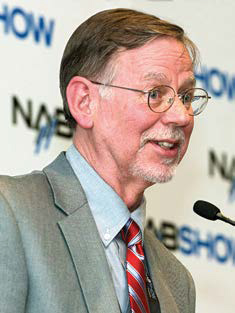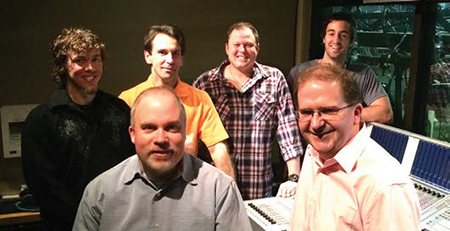Networked Audio Consoles Enhance Production Flexibility
LOS ANGELES —It’s becoming increasingly difficult these days to think of a digital audio mixing console as simply a standalone piece of equipment. More typically, the desk is part of a network that may be scaled up or down according to project requirements, can reach into the farthest corners of a location, and can introduce efficiencies in workflow through its ability to interconnect multiple locations as well as in reduced wiring.

Phil Owens, Eastern U.S. Sales for Wheatstone Corp. A networked audio console may offer flexibility in the use of the control rooms and studios at a TV station. “The example I frequently use is that stations pretty much across the board have an area in their newsroom set up for a single camera shoot,” said Phil Owens, Eastern U.S. Sales for Wheatstone Corp., in order to quickly produce cut-ins and program promotions. “It’s nice to be able to throw down a box—in this case, a Wheatstone Blade—and be able to get the talent audio from, and send IFB or any other playback sources to, that location.”
On a weather set, it may be necessary to report from the facility’s roof. “When somebody has to be standing in a blizzard upstairs, the I/O from the roof is simplified,” added Owens. “These are all places that can be reached by Cat5 or fiber.”
LINKED TO THE LINKS
Earlier this year, Calrec launched its Fieldbox, a remote I/O unit that can extend the reach of the company’s Hydra2 network. Pat Sullivan, president of Game Creek Video, whose trucks are all equipped with Calrec consoles, deployed two dozen Fieldboxes during the 2015 U.S. Open golf championship for Fox.
“We had to build a network to deal with 118 cameras, more than 200 microphones, and a massive number of line inputs,” Sullivan said. “We built the network for Fox with four Apollo consoles, one Artemis console, and two Summa consoles, all inside of our production trucks.”
The Fieldboxes fed 5.1 signals from various locations around Chambers Bay golf course to the trucks over fiber. “The Fieldboxes and their fiber links would make things much more efficient because not only would they save us from running DT-12 all over the golf course, but also because fiber is lighter, less obtrusive, and can carry more signals than DT-12,” said Sullivan, adding that Calrec’s built-in Hydra2 technology made it possible. “We had never attempted to tie five consoles together in a seamless package before, and without Hydra2, we wouldn’t have been able to do it,” he said.
In addition, DiGiCo consoles in the ISO production rooms were interconnected with the main production truck over MADI. DiGiCo recently introduced an interface that enables its desks to be linked directly onto a Hydra2 network.
“The ability to network all of the Calrec consoles together meant Fox’s audio engineers could access any audio at any time,” Sullivan said. “That flexibility let Fox cover any part of the course at any moment with the full resources that are normally only available to the main show.”
UNDER ONE ROOF
In the plant, too, any number of locations, including control rooms, edit bays, and production suites, can share sources and resources over a networked console system, thereby introducing workflow—and cost— efficiencies. “Where a network really starts to pay off is when you have more than one call letter in your building,” said Owens. “It can range from producing two separate sets of content coming off of two different sets to, more often, using the same studio and two different control rooms.
“On the set, you change over and, if you’re using two different control rooms, somebody can be going through the rundown in one room while they’re live on-air in the other room,” he added. “That can increase the efficiency and makes that kind of operation possible.”
Scaling up a network and adding devices, such as another console, is easy, Owens added: “Find an open port on one of your Gigabit switches, plug in the new devices, they auto-detect everything that is on the network, the network auto-detects them, and away you go.”

At Daystar Television Network in Dallas-Fort Worth, two Studer Vista 9 consoles and a Studer Vista 5 are networked through the Studer’s A-Link system. Back row (L to R): Jake Howard, Doug Leake, Shannon Kelly and Patrick Rioux; Front row (L to R): David Ribb, Director of Audio and Floyd CounceFIBER DIET
At Daystar Television Network in Dallas- Fort Worth, two Studer Vista 9 consoles and a Studer Vista 5 are networked through the manufacturer’s A-Link system, and over MADI, as well as via Riedel’s MediorNet router. Primarily designed to produce an almost daily program with a late-night talk show format, the Studer console system handles broadcast production plus front-of-house, monitor mixing and multitrack recording for live music in a very flexible two-studio space.
The show’s music component drives the high channel count—a total of 400 inputs plus about 100 outputs, 128 tracks of recording at each of three Pro Tools setups, and 192 channels moving between each of the three console locations, according to David Ribb, Daystar’s director of audio. “We have to have the capability on any given day to do two bands or groups side-by-side,” he explained.
“The studio Vista 9 tends to take care of all the frontend stuff, or all the analog side, with the broadcast Vista 9 handling all of the digital resources—embed feeds, AES feeds from external video routers, and satellite feeds,” said Audio Engineer Doug Leake.
“Each desk is able to pull from each console’s sources, with one desk functioning primarily as the head amp controller taking care of mic pre settings and the other desks following suit, doing digital trims as needed. We’re all soft-patchable from any location, from the desks. Then, going through MediorNet routing, we’re sharing all of those resources between all three desks,” Leake said.
“The Vista 5 is our third console for when we have larger bands in the second studio space and pick up an additional 96 inputs and 32 outputs. We can treat that as a local mix, more as a monitor position, or we can do it all from the studio Vista 9.”
Leake added, “We’re doing probably around 12 stereo in-ear mixes for bands and a few vocalists; the rest is for wedges and room fills.”
Unusually, Leake reported, “The studio Vista 9 is our [audience P.A.] system processor as well. We’re treating each speaker zone through the desk with on-board processing, not relying on an external systems processor for matrixing and DSP.”
Get the TV Tech Newsletter
The professional video industry's #1 source for news, trends and product and tech information. Sign up below.
Steve Harvey began writing for Pro Sound News and Surround Professional in 2000 and is currently senior content producer for Mix and a contributor to TV Tech. He has worked in the pro audio industry—as a touring musician, in live production, installed sound, and equipment sales and marketing—since November 1980.
